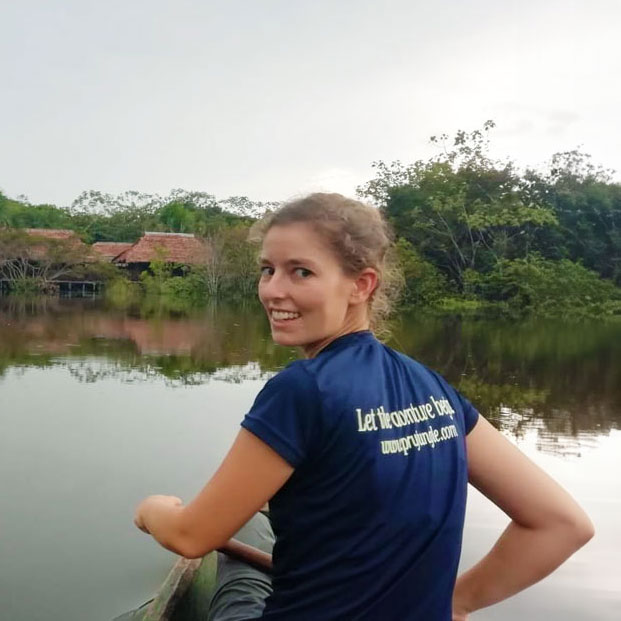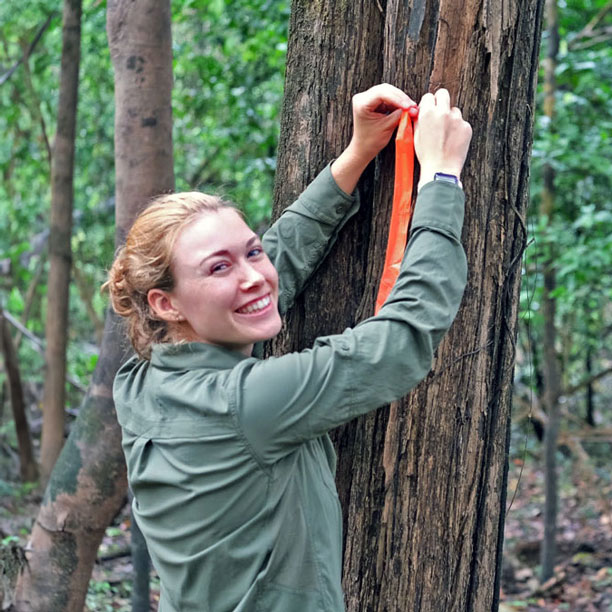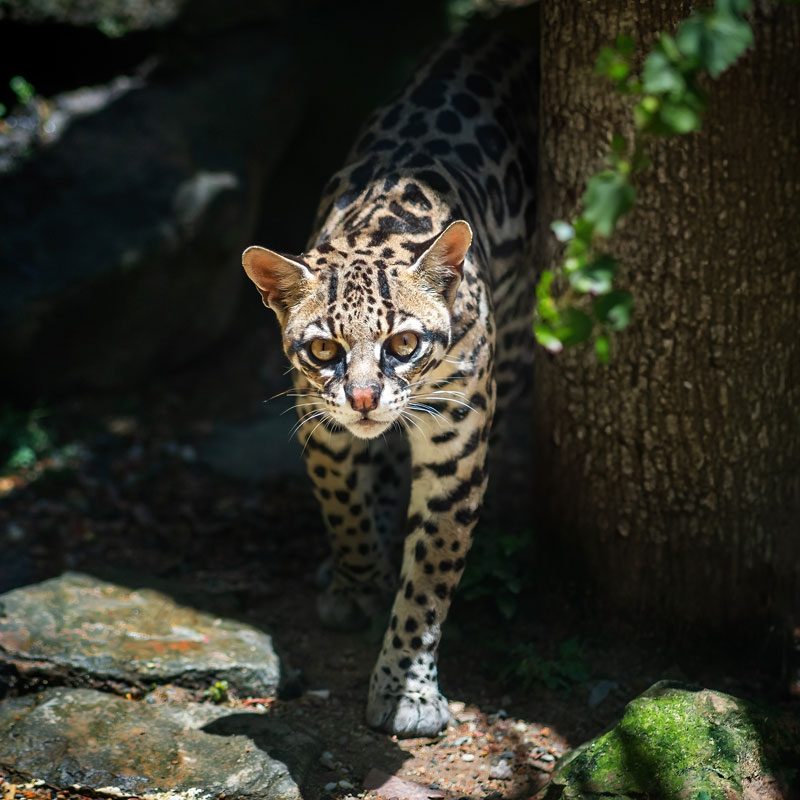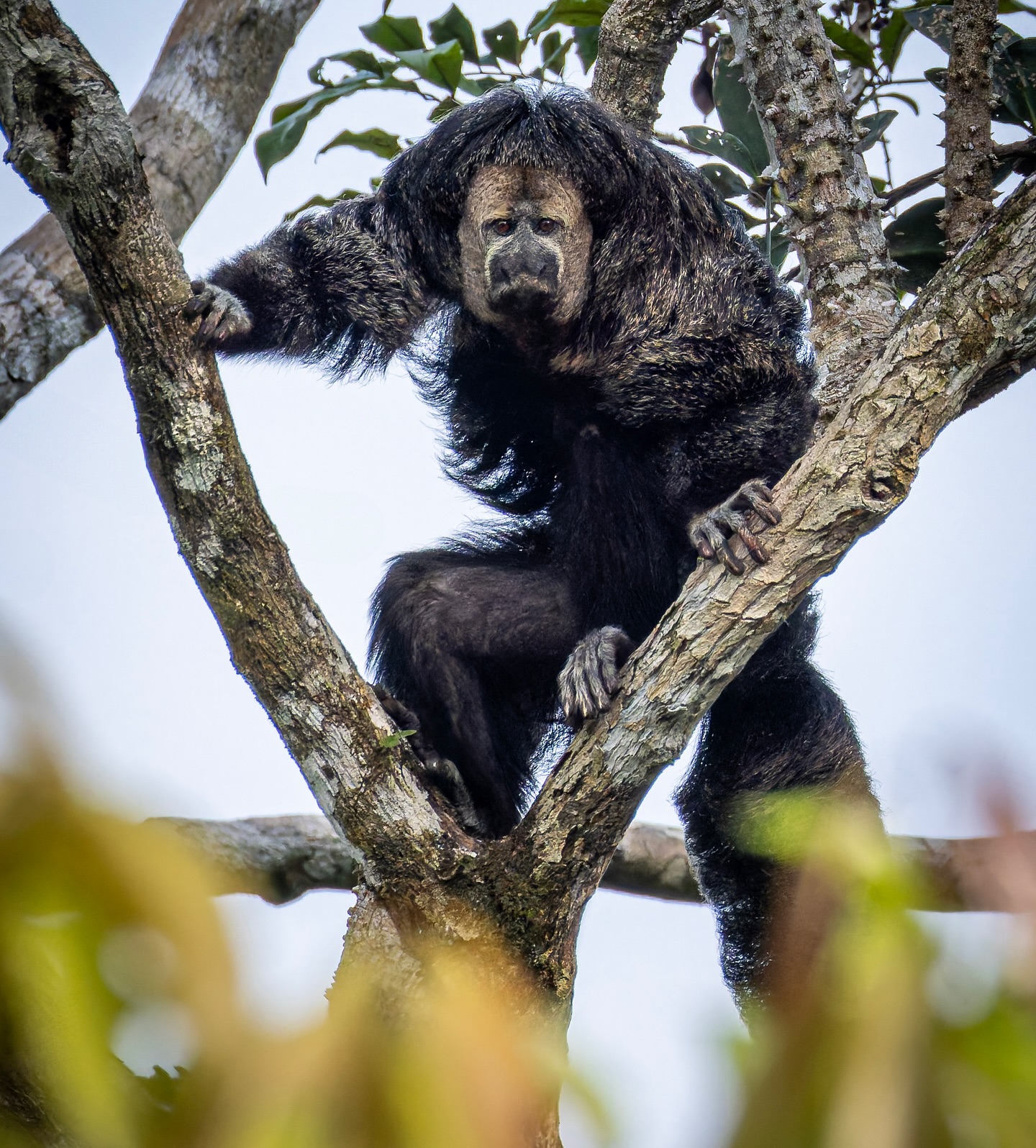Research at the Tahuayo Lodge:
Feeding ecology of monk sakis, Pithecia monachus, in a seasonally flooded forest in western Amazonia
Malika Gottstein, Abigail Lauren Morris, Katrin Heer, & Eckhard W. Heymann 2023
An investigation into the feeding habits of this elusive primate
Monk Saki Feeding Ecology
This research project conducted at the Amazonia Expeditions Research Center Lodge delves into the feeding behaviors and ecological adaptations of Saki monkeys in the Amazon rainforest. Led by Malika Gottstein and later continued by Abigail Morris, the study focused on understanding how seasonal changes influence the diet and daily life of these elusive primates. Through meticulous observation, data collection, and analysis, the researchers uncovered significant insights into the dietary preferences of Saki monkeys and the environmental factors that impact their feeding habits. The researchers found that seeds, ripe fruit pulp, and arthropods make up the core of the Saki monkeys’ diet – which was both in and out of alignment with past studies done on other species of Saki Monkeys. Their work also highlighted possible behavioral adaptations during the flooded season, setting the stage for further investigation into the ecological dynamics of these primates.
The Researchers

Specialized in tropical fieldwork and behavioral ecology
Malika Gottstein
Malika had already completed her degree in biology and her masters in ecology, evolution, and nature conservation when she came to work with Amazonia Expeditions. She had spent time at a German primatological center near the Amazonia Expeditions Lodges, the Estación Biológica Quebrada Blanco, during both her undergrad and masters experience studying bats and birds. It was here that she met Amazonia Expeditions founder Paul Beaver and agreed to join the team as a resident staff biologist. Since completing her research with Amazonia she has been able to put her experience to good use. As part of her doctoral research, Malika has gone on to study spider monkeys in Ecuador and has been able to leverage the methodology and logistics experience she gained with the sakis.

Investigating behavioral changes between seasons and environments
Abigail Morris
Abigail graduated from the University of Florida in 2021 with a degree in Zoology before joining Amazonia Expeditions as a resident staff biologist. She was interested in studying how animals respond to environmental changes of varying degrees – which made the seasonally flooding forests around the Amazon Research Center lodge a perfect location for her to dig into some research. Over the course of 2021, Abigail spent 6 months continuing the research of past staff biologist Malika Gottstein on how the changes in season impact the Sakis’ daily life – particularly their feeding ecology. Abigail is now a PhD student at UC Davis studying western lowland gorillas that move between a swamp and terra firme forest to better understand how their behavior differs in each environment.
A Surprising Encounter In the Rainforest
Memories from the Trail Grid
“Pretty early on in the study I was with Don Aladino and we were sitting quietly in the forest reading and waiting to hear any trace of the Saki Monkeys in the trees around us. Now, when you’re sitting quietly in the rainforest, it’s a lot harder for the wildlife to know you’re there (which was the goal) but it can make for some surprising encounters! Around 8 in the morning I was sitting on a log and I heard something move behind me – I turned around and came face to face with an Ocelot! It stared at me for about 10 seconds – and I stared right back before it turned tail and ran back into the forest. I had so many amazing moments with the Sakis – but that time with the Ocelot was definitely the most surprising!” – Abigail Morris

The Study
Supported by Amazonia Expeditions Guides and Logistics
Project Scope and Background
Research on Monk Saki Monkeys at Amazonia Expeditions lodges began with Janice Chism and several of her masters students who tracked and studied the Sakis over several years. After meeting Paul at the Estación Biológica Quebrada Blanco, Malika started the feeding ecology project alongside a handful of other potential projects with some having been identified as areas of interest by the Chism lab – one to investigate a possible second species of Sakis, one to study fleeing behaviors, and a fecal sample based kinship analysis. The feeding ecology project started with extensive preparation including acquiring permits and Peruvian residency with assistance from Amazonia Expeditions before Malika could begin designing the scope of work. Malika began the project in February of 2019 and after training with Malika for a week in 2021, Abigail stepped in to continue the project alongside Aladino Sr. and the other assistant guides.

Tracking the Elusive Saki Monkeys
A Research Day in the Amazon
Every day Malika or Abigail would head out from the lodge with their guide – either by foot on the trail grid or further into the rainforest by canoe. Much of the time was spent quietly sitting and waiting for a faint sign of the sakis – as shy creatures it took extra effort to be able to find one of their family groups. Once found – the next step was to get close enough to the monkeys to be able to properly observe them without scaring them off. This would often result in a prolonged semi chase where the quiet approach would be followed by a quick withdrawal of the sakis until the researchers could close the distance. They noted the number of individuals, what they were doing, and if they were eating. If the sakis were eating, the researchers tried to determine what was being eaten. This was done either using cameras or by investigating the food scraps and fecal samples after a group moved on. When possible – they would also snap photos of the sakis to be able to distinguish between the family groups.
Filling the gaps in our knowledge on yet another elusive creature
Saki Feeding Ecology Conclusions
From 459 separate feeding events, the researchers found that the most common food source for the Sakis were seeds (49%), then ripe fruit pulp (25%), then arthropods (22%), and the remainders were made up of leaves, bark, and flowers. They were able to identify 70 species of feeding plants from 29 different taxonomic famlies – but also believe that this is likely only a fraction of the plants actually consumed by monk sakis. They found that the sakis tend to eat seeds consistently year round but also that they eat a much higher density of insects during the flooded season. While they aren’t certain why – one theory is that once the river levels rise that the insects which had been living on the forest floor are forced up into the trees and are more available for consumption – but that would require an additional study to better understand! Their findings were not completely aligned with past research on other species of Saki – arthropod consumption in other studies was less notable as well as the consumption of ripe seeds as opposed to unripe ones. To better understand if these changes were the result of the species of saki or of their seasonally flooding habitats additional research would need to be completed on populations of monk saki that were restricted to nonflooded forests.
A Secluded Stay in the Heart of the Jungle
Visiting the Research Center
This research was supported by Amazonia Expeditions – an ecotourism company in the Peruvian Amazon dedicated to the environmental and cultural preservation of the region. For travelers visiting the Amazon for at least 5 days – there is the option to stay at our Amazon Research Center lodge (ARC) for all or part of your adventure. While the accommodations of this lodge are more modest than our main Tahuayo lodge– guests who are visiting the jungle to experience its spectacular biodiversity will find the pristine, undisturbed forest it provides access to well worth it. The ARC is the only existing man-made structure in the million acre ACRCTT conservation zone with the nearest human habitation over 15 km away.




